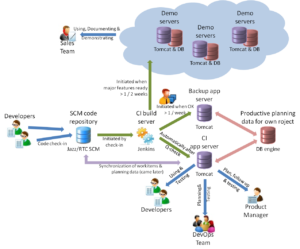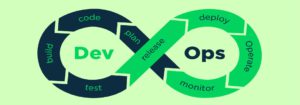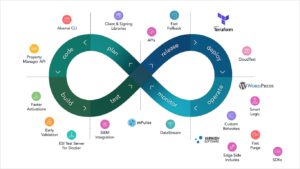 Significance of Open Source and DevOps for Software Development.
Significance of Open Source and DevOps for Software Development.
DevOps and open source techniques are at the helm of software development projects. Enterprises no longer consider open source to be a high-risk technique and are embracing open source for their software development stacks. IBM’s acquisition of Red Hat and Microsoft’s acquisition of Github are the testimony to the fact that open source technology is here to stay.Enterprises need to start open sourcing their code in order to stay relevant in the market. DevOps technology is also a prerequisite, where the open source codes can be layered. The DevOps teams will have to enforce open source policies to ensure compliance against practices. The teams will also have to automatically update continuous integration (CI) and continuous delivery (CD) servers with the latest open source language build. An automated, reproducible, and continuous Build Engineering process can help DevOps teams to ensure a truly agile framework with continuous builds for the DevOps process.
 DevOps technique allows software teams to test their codes in the development process only, accelerating the software production process. Companies need to integrate securities into their code to enable runtime monitoring that provides insights into new vulnerabilities. DevSecOps helps an enterprise in Build management with strong focus on security. It allows an enterprise to build only what is required and standardize the builds based on language, operating system, and vetted packages. DevSecOps offers more robust and faster application delivery as the open source language builds won’t need distributions loaded with every package. Here are a few open source features that are important for software development:
DevOps technique allows software teams to test their codes in the development process only, accelerating the software production process. Companies need to integrate securities into their code to enable runtime monitoring that provides insights into new vulnerabilities. DevSecOps helps an enterprise in Build management with strong focus on security. It allows an enterprise to build only what is required and standardize the builds based on language, operating system, and vetted packages. DevSecOps offers more robust and faster application delivery as the open source language builds won’t need distributions loaded with every package. Here are a few open source features that are important for software development:
Language-level automation: Automated open source language provides reproducible processes which result in continuous language builds. These builds enable organizations to accelerate productivity and give more freedom to developers.
A trusted source of information: A centralized open source languages and the related packages, dependencies and licenses enable a business organization to track their language and packages across DevOps and provide a comprehensive understanding of open source usage.
Heading into 2019 with DevOps Application
A willingness to adopt change and the ability to do speaks a lot about an organization. The flexibility is something demanded by the market and rewarded as well, the speed of responsiveness from the providers becomes the big differentiator between a company and its competitor. DevOps has evolved big time and has proved that it is not just a buzzword and is worth the hype. Below mentioned are six goals that will shape the future of DevOps.
Paying debts should be a priority
Majority of companies hire new employees to cope up with the technical debt, but they fail to realize that this will add more burden to their organization. Instead, organizations must dedicate a portion of their workforce to eliminate the technical debts that are fuelling the operational firesDevOps (deve
Goals and Objectives
Set goals and objectives but let the little information to be developed in short intervals. Employers must set ambitious goals and objectives, but they must be careful not over to prescribe the details. Organizations must plan to monitor their work every two to four weeks, instead of focusing on a six-month project plan.
Go with the flow
Though DevOps is a quickly moving product, organizations usually wait for the right time and then jump headlong into DevOps, creating a lot of disruption at once which is not healthy for any organization. One has to go with the flow but identify work streams that are ripe for improvement and start moving one new benefit from conception to production.
Neutralize Credit Hawks
The critical aspects of DevOps are sharing everything- knowledge, work, credit, and blame. ‘Credit Hawk’ is someone who wants to jump in front of the work which is already done and claim that he managed it. This kind of work environment leaves the DevOps teams with the blame, and this is unhealthy; hence it becomes essential to neutralize these hawks.
Plan for both failure and success
Planning for failure doesn’t imply that one has to expect the failure. This will help in understanding the lessons, and incorporate the feedback cycle to increase the likelihood of success.



